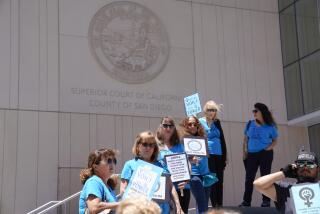Early release rules to be revised
- Share via
Driven by prosecutors’ concerns about fairness, top Los Angeles County law enforcement officials said Wednesday that they would introduce sweeping changes to the sheriff’s early release policy.
The new rules would keep most inmates in jail longer, but some categories of criminals -- including child molesters, spousal abusers and some other serious offenders -- would see their sentences slashed.
Nearly 200,000 inmates have been let go early since mid-2002 -- the vast majority walking out after serving no more than 10% of the time ordered by a judge. By year’s end, officials said, they expect that all inmates sentenced to county jail will serve at least 25% of their sentences. It’s a policy shift that Los Angeles County Sheriff Lee Baca and Dist. Atty. Steve Cooley both support.
The change drew criticism from some lawmakers and victims advocates. But officials said it would eliminate the county’s risk of being sued on claims that treating inmates differently is unconstitutional. Baca said he also acted out of concern that savvy defendants were refusing to agree to work release or community service programs, knowing they would leave jail within days.
“I want to end the gaming of early release by defendants in court,” Baca said. “I trust what the district attorneys and city attorneys are telling me. They can’t get the plea bargains at the level they’d like to see.”
David Bennett, a Park City, Utah, criminal justice consultant who specializes in jail overcrowding, criticized the new policy for failing to take into account which prisoners are a risk to the community and what sorts of treatment and supervision they would need.
“Where what they were doing before was absurd, this takes it to a new level,” he said. “It needs to be an individualized decision. We can’t just apply an equation to this.”
The new policy aims to increase time behind bars for the vast majority of inmates. For example, instead of serving about two weeks of a 180-day sentence, a prisoner now will serve a little more than a month. The shift also is expected to end the current practice of immediately releasing anyone sentenced to 90 days or less.
But the new rules also give significant breaks to categories of convicts who jailers had determined should be held longer because of the nature of their crimes.
Those sentenced to a year in jail for vehicular manslaughter, for example, now serve about nine months. Under the new policy, they would serve about 60 days before being eligible for release. Spousal abusers, whom Baca had begun holding for at least 50% of their sentence after complaints from judges and victims rights advocates, would serve half that amount.
The sheriff also has held some convicts longer depending on where their crimes were committed. Gang members arrested in Hawaiian Gardens or by the Compton Violent Gang Task Force -- two areas targeted by the sheriff -- serve 100% of their time for any conviction, even as gang members from elsewhere in the county are released early for the same offenses. Those discrepancies upset some area prosecutors and civil rights advocates.
Cooley said that although prosecutors would prefer that no one was released early, the county doesn’t have enough jail space.
The new policy, he said, offers major improvements, eliminating “equal protection” questions raised by the current practice of allowing some inmates to serve no time, others to serve only 10% and still others to be held for 100% of their sentences. Jailers, he said, were in effect usurping judges’ decisions.
“I find that incredibly upside down and backwards, arbitrary, capricious and unacceptable,” Cooley said. “Prostitutes in Long Beach did no time and prostitutes in Compton did all their time,” he said. “How does that make sense? It’s a county jail system, and it needs to work equally for everyone. For so many offenses that were sentenced to jail, they did no time.”
But the policy shift was criticized by County Supervisor Mike Antonovich and some victims rights advocates.
“Those who are arrested for serious and violent felonies in my opinion and the public’s opinion need to do 100% of their time,” Antonovich said. “One size doesn’t fit all. You have to look at the type of individual. The gangbanger who shoots innocent people on a street corner is not the same type of person who may have passed a bad check.”
Teresa Trinidad, program manager of Haven House, a San Gabriel Valley shelter for battered women, criticized the new policy of spousal abusers serving 25% of their sentence as “just a slap on the hand.”
But Baca defended the change, saying he thought such convicts did not belong in county jail at all. “If that person is such a threat, then the court should never have sent the person back to county jail,” he said. “They should have sent them to state prison.”
Jonathan Diamond, spokesman for Los Angeles City Atty. Rocky Delgadillo, said it was too soon to know the effect of the new sentencing system.
“That said, it’s been our belief for some time that certain crimes -- such as domestic violence and child abuse -- shouldn’t be treated as other crimes,” he said. “In a lot of cases, these defendants -- in cases we see -- are pleading down from more serious crimes.”
Baca began large-scale early releases in mid-2002 as part of major county budget cuts. He has little discretion to release inmates who are awaiting trial -- more than 90% of those held in Los Angeles County jails. But long-standing federal court orders allow him to free early those sentenced to county jail to alleviate overcrowding.
It was unclear Wednesday how applying early release equally to all county-sentenced inmates would affect jail overcrowding.
This year, a Times investigation found that many inmates released early were accused of committing new crimes during the time they would have been in custody. Among those cases were 16 accused of murder, 518 charged with robbery and 215 charged with sex offenses.
After The Times published its findings, the Sheriff’s Department vowed to look into inmates’ criminal backgrounds before deciding whether to grant them early releases. The goal, officials said, would be to hold for their entire sentences those with past convictions for violent offenses.
Cooley, however, described the new policy as the “fairest approach.” He said the county was suffering the consequences of failing to build and maintain a jail system large enough to handle a growing population, even though it had been almost 30 years since a federal judge ordered county officials to end overcrowding in the jails.
“The reality is that we have to build more facilities and staff them,” he said. “That should be the public safety highest priority.”
[email protected] [email protected]
More to Read
Sign up for Essential California
The most important California stories and recommendations in your inbox every morning.
You may occasionally receive promotional content from the Los Angeles Times.











